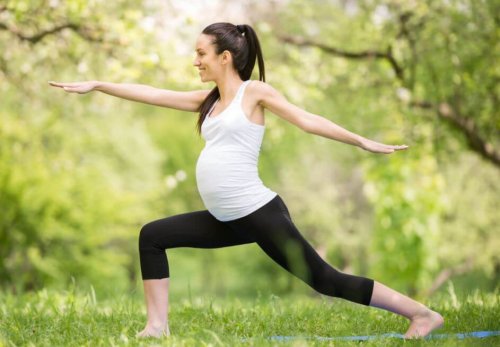Exercising During Pregnancy: Tips And Influences on Your Body

Each pregnancy is different, although exercising during pregnancy is generally beneficial. However, it’s important to consult with your physician before beginning any exercise routine. Firstly, you also have to take into consideration whether you were exercising before you became pregnant.
If you previously exercised regularly, you can usually continue to do so throughout pregnancy. Just remember to adjust your routine accordingly. This way, you can maintain your physical, cardiovascular, and muscle fitness level during your pregnancy, and after giving birth.
In contrast, there are women who have never exercised. This doesn’t mean that you can’t start once you’re pregnant; in fact, you can even benefit from exercising during pregnancy. However, you’ll need to plan different exercises that are adapted to your physical fitness level.
The benefits of exercising during pregnancy
Exercising during pregnancy has more advantages than disadvantages. Furthermore, it doesn’t generally pose any risks to the unborn baby. It also helps expectant mothers to stay in shape and improve their physical and mental health. Both during and after the birth

Some of the most notable benefits of exercising during pregnancy include:
- Improving physical, cardiovascular, and muscular fitness
- Speeding up recovery following childbirth
- Helps you get back to your pre-pregnancy weight, strength, and flexibility
- Flatter stomach after childbirth
- More energy
- Fewer obstetric interventions
- Shorter and less painful labor
- Less weight gain
- Improved mood and self-esteem
- Less stress, anxiety, and depression
- Increases the chances of adopting permanent healthy lifestyle habits
In addition, maintaining an exercise routine can help to prevent the risk of developing pregnancy-related conditions, such as pre-eclampsia (pregnancy-induced hypertension) and gestational diabetes.
Influences of exercise on your pregnancy
Exercising during pregnancy helps to improve insulin secretion, insulin sensitivity, and glucose metabolism. In other words, it improves glucose tolerance and therefore reduces the chances of developing gestational diabetes.

What’s more, working out can prevent lower back pain, pregnancy-related urinary incontinence, and other chronic musculoskeletal disorders.
Tips for exercising during pregnancy
As long as you don’t have any other medical issues, and your physician agrees, exercising during pregnancy can also give you a sense of well-being.
However, studies show that performing intense exercise during pregnancy can lead to a lower birth weight. Although, this can be due to lower subcutaneous fat and shouldn’t be an issue. Still, it’s advisable to perform moderate physical activities during pregnancy.
Recommended exercises during pregnancy
–Walking during pregnancy is very beneficial and you can do it from day one. It’s a way to encourage a natural birth too. By walking, you can prevent circulatory problems and their consequences – swelling of the legs and feet, constipation, etc. Furthermore, walking helps to effortlessly control weight gain, since it’s an aerobic exercise.
-Riding a bike during pregnancy relaxes, distracts, and tones your body. What’s more, it curbs excess weight and improves your circulation. It’s not recommended after the fifth or sixth month of pregnancy. An option for the final trimester, is the stationary bike, since pregnancy can destabilize the balance you would normally have on a bicycle.

More pregnancy exercises
–Exercising in water makes your body lighter. Therefore, it lowers your risk of injuries or putting too much strain on your muscles. Another advantage is that your body won’t overheat while in water. Swimming and aqua aerobics improve your muscle, circulatory, and respiratory health, while reducing lower back pain and enabling you to relax.
–Prenatal yoga improves body posture and helps to prevent back pain and conditions such as, hemorrhoids and nausea. It also helps to lower blood pressure and maintain your weight, as well as reducing fatigue, and nervous tension. Furthermore, prenatal yoga can provide the fetus with a better oxygenation supply.
Finally, yoga is relaxing for the mother and can make her more aware of the baby’s presence. This is thought to enhance their bond and communication before the baby is born.
–Pilates is also beneficial and provides similar advantages to yoga. You just have to avoid poses or exercises that put pressure on your belly, or that could make you lose your balance.
Each pregnancy is different, although exercising during pregnancy is generally beneficial. However, it’s important to consult with your physician before beginning any exercise routine. Firstly, you also have to take into consideration whether you were exercising before you became pregnant.
If you previously exercised regularly, you can usually continue to do so throughout pregnancy. Just remember to adjust your routine accordingly. This way, you can maintain your physical, cardiovascular, and muscle fitness level during your pregnancy, and after giving birth.
In contrast, there are women who have never exercised. This doesn’t mean that you can’t start once you’re pregnant; in fact, you can even benefit from exercising during pregnancy. However, you’ll need to plan different exercises that are adapted to your physical fitness level.
The benefits of exercising during pregnancy
Exercising during pregnancy has more advantages than disadvantages. Furthermore, it doesn’t generally pose any risks to the unborn baby. It also helps expectant mothers to stay in shape and improve their physical and mental health. Both during and after the birth

Some of the most notable benefits of exercising during pregnancy include:
- Improving physical, cardiovascular, and muscular fitness
- Speeding up recovery following childbirth
- Helps you get back to your pre-pregnancy weight, strength, and flexibility
- Flatter stomach after childbirth
- More energy
- Fewer obstetric interventions
- Shorter and less painful labor
- Less weight gain
- Improved mood and self-esteem
- Less stress, anxiety, and depression
- Increases the chances of adopting permanent healthy lifestyle habits
In addition, maintaining an exercise routine can help to prevent the risk of developing pregnancy-related conditions, such as pre-eclampsia (pregnancy-induced hypertension) and gestational diabetes.
Influences of exercise on your pregnancy
Exercising during pregnancy helps to improve insulin secretion, insulin sensitivity, and glucose metabolism. In other words, it improves glucose tolerance and therefore reduces the chances of developing gestational diabetes.

What’s more, working out can prevent lower back pain, pregnancy-related urinary incontinence, and other chronic musculoskeletal disorders.
Tips for exercising during pregnancy
As long as you don’t have any other medical issues, and your physician agrees, exercising during pregnancy can also give you a sense of well-being.
However, studies show that performing intense exercise during pregnancy can lead to a lower birth weight. Although, this can be due to lower subcutaneous fat and shouldn’t be an issue. Still, it’s advisable to perform moderate physical activities during pregnancy.
Recommended exercises during pregnancy
–Walking during pregnancy is very beneficial and you can do it from day one. It’s a way to encourage a natural birth too. By walking, you can prevent circulatory problems and their consequences – swelling of the legs and feet, constipation, etc. Furthermore, walking helps to effortlessly control weight gain, since it’s an aerobic exercise.
-Riding a bike during pregnancy relaxes, distracts, and tones your body. What’s more, it curbs excess weight and improves your circulation. It’s not recommended after the fifth or sixth month of pregnancy. An option for the final trimester, is the stationary bike, since pregnancy can destabilize the balance you would normally have on a bicycle.

More pregnancy exercises
–Exercising in water makes your body lighter. Therefore, it lowers your risk of injuries or putting too much strain on your muscles. Another advantage is that your body won’t overheat while in water. Swimming and aqua aerobics improve your muscle, circulatory, and respiratory health, while reducing lower back pain and enabling you to relax.
–Prenatal yoga improves body posture and helps to prevent back pain and conditions such as, hemorrhoids and nausea. It also helps to lower blood pressure and maintain your weight, as well as reducing fatigue, and nervous tension. Furthermore, prenatal yoga can provide the fetus with a better oxygenation supply.
Finally, yoga is relaxing for the mother and can make her more aware of the baby’s presence. This is thought to enhance their bond and communication before the baby is born.
–Pilates is also beneficial and provides similar advantages to yoga. You just have to avoid poses or exercises that put pressure on your belly, or that could make you lose your balance.
This text is provided for informational purposes only and does not replace consultation with a professional. If in doubt, consult your specialist.








